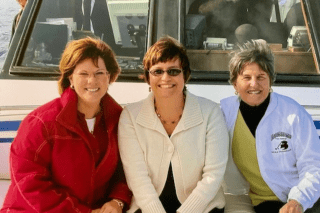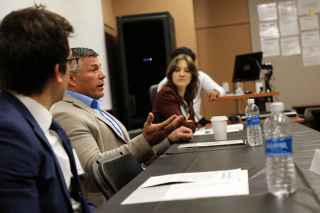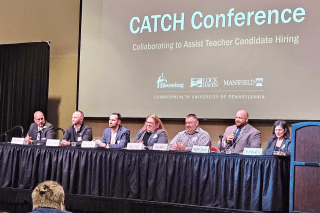Ocean Life: Bloomsburg grad interns with marine research academy
Posted:
Article originally appeared in the Juniata Sentinel, a weekly newspaper in Mifflintown, Juniata County, on March 9, 2022.
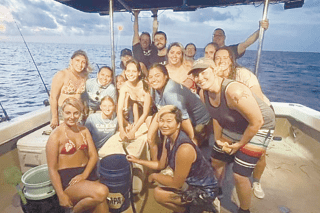
MIFFLINTOWN — One rainy day last August, Mackenzie Yohn, of Mifflintown, found herself aboard a research ship miles off the coast of Florida. While gulls squawked overhead, Yohn and her 14 or so crewmates worked to haul in a long line, a type of net used to catch various species of fish.
Then a Bloomsburg University senior, Yohn was wrapping up the last few months of her study in biology/natural history with a three-week internship at the Coastal Marine Education and Research Academy in Clearwater, Florida.
“It was a dream come true,” she said.
On that rainy Tuesday, the long line was awfully heavy. A 6-foot, 8-inch tiger shark squirmed inside.
‘So cool’
Yohn graduated from Juniata High School in 2018 and promptly chose Bloomsburg as the university where she wanted to further her education.
“Ever since fifth grade, I knew that I wanted to do marine biology. I think it’s because sea turtles have always been my favorite animal. I always knew I wanted to do something with them,” Yohn said. “Bloomsburg doesn’t have a marine biology [focus] of study; natural history was the closest that I could get.”
She credits family vacations to the Outer Banks in North Carolina with introducing her to the species of saltwater turtle that sparked her interest in an occupation impossible in landlocked central Pennsylvania.
“The Pea Island Wildlife Refuge [at the Outer Banks] has a couple different kinds of sea turtles there, and I just thought they were so cool,” Yohn said.
All six species of sea turtles that are found in U.S. waters are listed and protected under the federal Endangered Species Act. During Yohn’s internship, if researchers caught a turtle in their nets, they had to contact the Florida Fish and Wildlife Conservation Commission and “go through a process” to ensure the safe release of the creature.
Hands wet
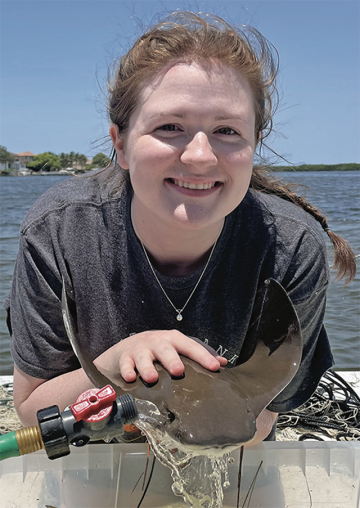
The internship counted as one of her last courses for college credit.
“My adviser … said I should go for it,” she said. “He just thought that I would love it. It gives students the opportunity to do something that they otherwise probably wouldn’t be able to do.” Yohn was the only Bloomsburg University student to pursue an internship at the Coastal Marine Education and Research Academy last summer. Students can spend different lengths of time studying there.
“The program fills up really fast, so I was lucky to get the three weeks that I got,” Yohn said. “Bloomsburg’s requirement was three weeks; some [internships] were as long as eight weeks.”
At the academy, students lived in condos and met for hourlong classes in the morning.
“Then they took you to the boats for eight hours. So, it would be all day out on the boat. It was that five days a week,” she said.
Despite all those years vacationing at the Outer Banks, “I had never been on a boat, so I was a little worried [about getting seasick],” Yohn said. “But I was fine. I didn’t want to ever get off of the boat.”
It was the hands-on aspect of the experience that most thrilled Yohn.
“They focus on sharks and stingrays. You get to catch them and measure them and tag them,” she said. “They collect research for bigger projects that they do. It was just really cool to be able to apply what I was learning to real life.”
The best experience
Ask Yohn what her favorite part of the internship was and she answers with no hesitation: ”The tiger shark that we caught. It was 6.8 feet, and it was amazing.”
But the quantity of sea life that the students found was lower than other groups had seen, she said.
“When I was there, there was a red tide. It’s an algal bloom and it takes over everything,” Yohn explained. “It will kill all of the things that the sharks and the rays eat, and they’ll move away. Any other time of the summer, any other year, we would have caught so much more.
“Being able to see the tiger shark was very lucky,” she said. “The tiger sharks are the main focus of their [the academy’s] research, so they satellite tag them so they can track them.”
The one Yohn helped to catch was a female that the researchers had caught earlier in the season. Its tag, however, secured to its dorsal fin, had fallen off.
A different kind of net was used to capture other sea life.
“To catch the stingrays and the sea turtles, we used a tangle net, and that was a lot easier,” she said. “It would have a weight on the bottom to pull it down and a buoy on the other side. It stretched across a certain number of feet so anything that swam into it we would be able to pull back up onto the boat.”
Though catching the turtles was not a goal of the researchers, “it was very exciting for me,” Yohn said.
The crew saw firsthand how garbage in the ocean affects wildlife.
“The one sea turtle we caught, we pulled out as much of the fishing line as we could, but she had to be taken to the Clearwater Aquarium. They were hoping they would be able to pull the rest out and save her, but they had to put her down. It was very sad.
“Anytime we would pass any bottles in the ocean, they would make sure to get a net to get it out,” she said.
‘I’m ready’
As part of her internship experience, Yohn emailed her adviser a journal entry every day, then collected them into one document, complete with photos she took onboard the vessels.
“I had to write a report about how my classes at Bloomsburg helped and the new stuff that I learned,” she added, noting that a site adviser evaluated her work and talked to her adviser at Bloomsburg, too.
The experience only solidified her dreams for the future.
“Eventually, I want to work at an aquarium — hopefully, in North Carolina,” Yohn said. “It is amazing.”
She works locally in Juniata County and is saving money in hopes of soon moving to North Carolina: “I’m ready.”

